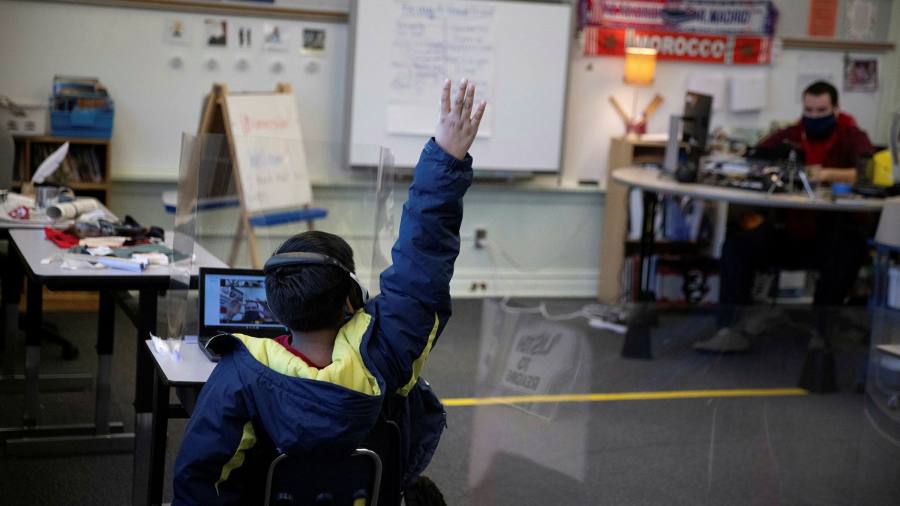[ad_1]
As staff at Strive Collegiate Academy in Nashville prepare for the school’s reopening this month, principal LaKendra Butler is grappling with the best way to support pupils after a traumatic year in which their education was thrown into chaos by the pandemic.
“Our students are performing 10-15 per cent below the level a year ago,†Butler said. “Right now I’m prioritising their time during the school day and making sure we’re focused on bringing them back . . . [but] longer-term we need to look at how to do school differently. We can’t go back to the status quo.â€
Strive is one of tens of thousands of schools around the world, from the US to the UK and the Netherlands, that will reopen their doors in the coming weeks, as students return to the classroom after months of often solitary online study.
A first priority will be regular Covid-19 tests and measures to cut the risk of the virus spreading in schools. The longer-term challenge will be assessing how far behind pupils have fallen in their academic and emotional development and finding ways to rectify the problem with often limited resources.
Getting students back into the classroom is just the start. Many educators believe schools will need to adopt radical new approaches to learning and spend eye-watering sums of money to close the “learning gap†and prevent a generation being scarred, their prospects set back permanently.

“Covid has been the largest disruption to education in history,†said Per Engzell, a researcher at the Oxford Leverhulme Centre for Demographic Science in the UK. “Ninety-five per cent of children were affected and in many countries schools have remained closed since [last] March. It’s totally unprecedented.â€
Using detailed testing in the Netherlands, his team has identified an “alarming†average loss of learning equivalent in that country to one-fifth of the academic year — the entire period students were out of school in 2020. The finding “seems to bear out some of the worst misgivings on the magnitude of learning loss and social disparitiesâ€, he said.
The pattern is similar elsewhere. Jonathon Guy, research officer at the Australian Education Union, said the learning loss was even more marked for children from marginalised communities and disadvantaged groups. “Demographic factors, low levels of prior achievement and a lack of access to technology are the main concerns,†he said.
Surveys in Australia and other countries suggest widespread disparities in access to computers, affordable internet, safe places to learn and supportive home environments.

Luke Sibieta, a researcher at the UK’s Institute for Fiscal Studies, has estimated that British pupils could lose a combined £350bn over their lives as a result of missed education during lockdown. According to a forecast by the World Bank, globally the loss could be as much as $10tn if effective policy responses were not introduced.
Those responses will not come cheap. In the UK, Sibieta suggested £30bn — equal to six months of spending on schools — as a useful benchmark for what the government should consider spending on “radical and properly resourced ways to help pupils catch upâ€.
Some teachers have sought to learn from approaches adopted after previous disruptions, such as when Hurricane Katrina overwhelmed New Orleans in 2005. Then, a so-called spiralling technique was used to reteach essential missing skills before proceeding with scheduled lessons.
David Steiner, head of the Johns Hopkins Institute for Education Policy in the US, who led a review of “catch up†techniques for Unesco, said the evidence was against strategies that promoted students automatically to the next grade regardless of the gaps in their learning or got them to retake the entire year with a younger class.
Instead, he called for “acceleration†programmes to test students and focus on missing skills essential to the next stage of study. “You need to narrow the list of topics to those that really matter and do ‘just-in-time’ instruction so they’re ready to take regular classes with grade-level peers,†he said.

Butler has carved out two hours during her school’s daily schedule away from normal lessons, to focus on teaching in one-on-one and small group sessions, guided by periodic assessments of students’ progress and surveys of their parents.
She is also exploring more use of tutoring, an approach that has garnered attention around the world, including in a £1.7bn package in Britain. The UK has also appointed an “education recovery tsar†who has made clear that the catch-up would take years of work and “radical†curriculum changes.
James Turner, head of the Sutton Trust, a charity participating in the UK tutoring programme, said this was an essential response. “It’s not the complete solution but the evidence is very strong,†he said, estimating that the country would need 20,000 additional tutors to meet its objective of supporting 250,000 pupils in the current school year.
Matthew Kraft, associate professor of education and economics at Brown University in the US, cautioned that while there was strong evidence for the value of tutoring in small groups, “we know much less about scaling and maintaining its effectivenessâ€.
He proposed a “peer-to-peer†volunteer system where older students helped younger ones, to reinforce their own learning and give something back.
Jelmer Evers, a teacher in the Dutch city of Utrecht and vice-president of the country’s General Education Union, said the task was best tackled by qualified teachers, despite a backdrop of falling numbers entering the profession. They had greater knowledge of their students’ needs and of the curriculum than external tutors, he said.
For Amy Wood, principal at Mossbourne Riverside Academy in London, student wellbeing and social activities would be as important as academic work when her pupils return on Monday.
She remained optimistic. “Children are more resilient,†she said. “They’ll bounce back.â€
[ad_2]
Source link






